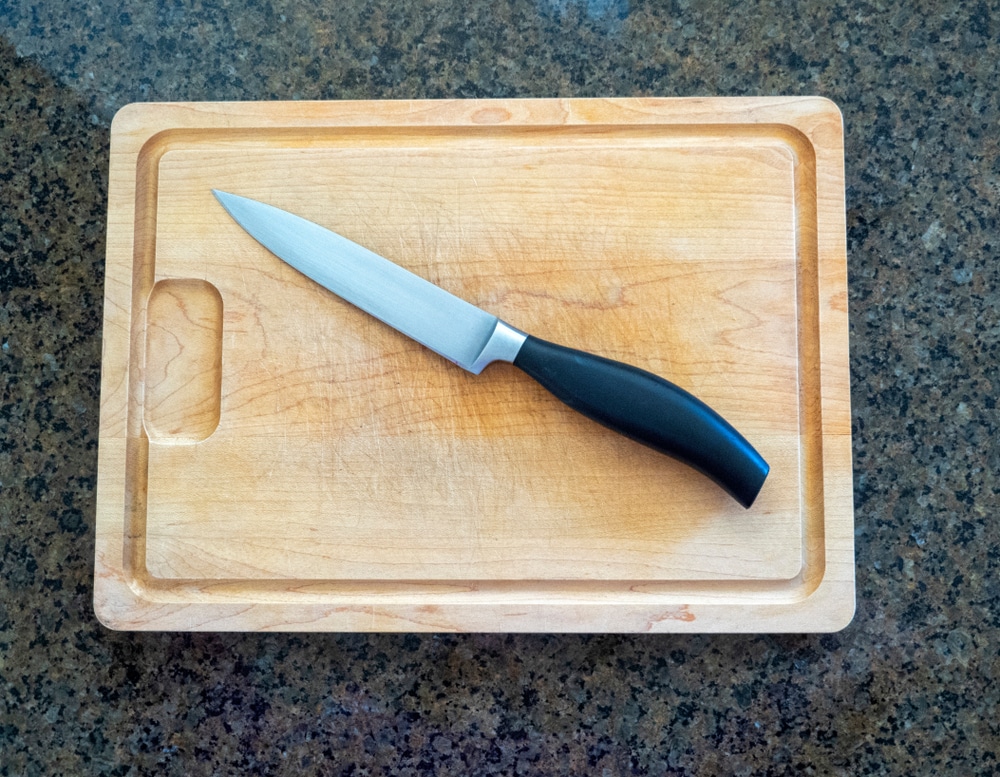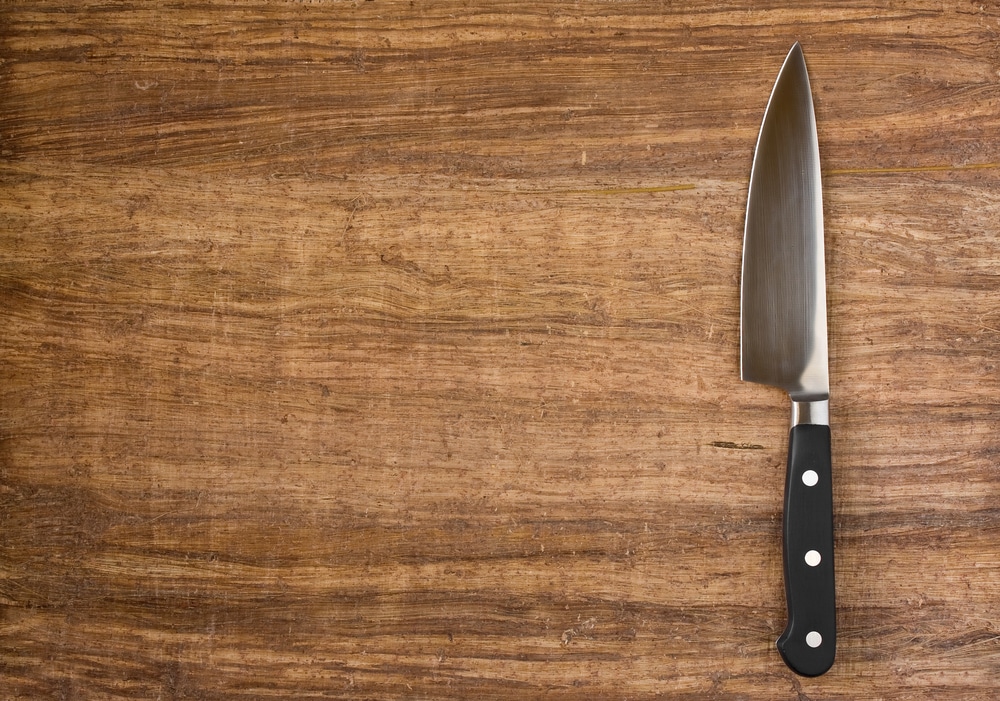A well-equipped kitchen doesn’t require dozens of specialized tools, but having the right kitchen knives can transform your cooking experience from frustrating to enjoyable. Whether you’re a culinary enthusiast or someone who simply wants to prepare meals efficiently, investing in quality kitchen knives is one of the smartest decisions you can make. These five essential kitchen knives will handle virtually any cutting task you encounter, from delicate herb chopping to breaking down a whole chicken. Let’s explore the must-have kitchen blades that deserve a permanent place in your kitchen arsenal.
1. Chef’s Knife (8-10 inch) – The Kitchen Workhorse

The undisputed workhorse of the kitchen, a quality chef’s knife is the foundation of any respectable kitchen knife collection and likely the tool you’ll reach for most often in your daily cooking.
Why it works: The chef’s knife combines versatility with efficiency through its distinctive curved blade that allows for the rocking motion essential for quick chopping. The wide blade also serves as a convenient tool for transferring cut ingredients from cutting board to pot.
What makes it essential: This all-purpose kitchen knife handles about 90% of your kitchen cutting needs. From dicing onions and mincing garlic to breaking down poultry and slicing roasts, a good chef’s knife makes quick work of tasks that would be awkward or impossible with specialty knives. The substantial weight and balance of a proper chef’s knife also reduces the effort needed for cutting through denser foods.
Shopping tip: Look for a chef’s knife that feels comfortable in your hand—this is more important than price point or brand name. The knife should have good balance, meaning it doesn’t feel too heavy in the blade or handle. For most home cooks, an 8-inch blade offers the perfect balance between power and maneuverability.
Why you’ll love it: “I was intimidated by my chef’s knife at first, but once I learned proper technique, it became an extension of my hand. I can prep an entire meal with just this one kitchen tool, and the efficiency has cut my preparation time in half.” – Marcus T.
2. Paring Knife (3-4 inch) – Perfect for Precision Tasks

For precision tasks where your chef’s knife feels too unwieldy, the paring knife steps in as the perfect complement with its small blade and nimble handling.
Why it works: The paring knife excels at detailed cutting tasks through its short, narrow blade that allows for intricate control. Unlike larger kitchen knives, a paring knife is designed to be used both on and off the cutting board, making it ideal for in-hand tasks like peeling fruits or deveining shrimp.
What makes it essential: When precision matters more than power, nothing beats a paring knife in your kitchen knife set. It’s perfect for trimming mushrooms, hulling strawberries, segmenting citrus, and other delicate tasks that require finesse. The small size also makes it appropriate for children learning knife skills under supervision.
Shopping tip: Look for a lightweight paring knife with a comfortable handle and blade between 3-4 inches. The blade should be thin but rigid, as flexibility isn’t typically desirable in a paring knife.
Why you’ll love it: “My paring knife is my secret weapon for all those fussy little jobs that used to frustrate me. Removing seed packets from bell peppers, creating garnishes, even opening packages—it’s become the kitchen knife I keep closest at hand.” – Amara L.
3. Serrated Bread Knife (8-10 inch) – The Gentle Slicer

The distinctive saw-toothed edge of a bread knife makes it an irreplaceable kitchen knife for specific cutting tasks that would crush or tear with a straight-edged blade.
Why it works: The serrated edge of a bread knife creates a saw-like cutting action that slices through foods with tough exteriors and soft interiors without compression. The length allows for long, smooth cutting strokes that maintain the integrity of delicate items.
What makes it essential: While “bread knife” is in the name, this versatile kitchen tool goes far beyond bread. It’s the ideal choice for slicing tomatoes without squishing them, cutting through the tough rind of pineapples and melons, leveling cake layers, and of course, slicing through crusty bread without crushing the soft interior. Many tasks that frustrate with other kitchen knives become effortless with a good serrated knife.
Shopping tip: Opt for a bread knife with widely spaced serrations rather than small, closely packed teeth. This design cuts more efficiently and is easier to sharpen when necessary. A length of at least 8 inches ensures you can tackle larger loaves with ease.
Why you’ll love it: “I used to mangle my sourdough loaves until I invested in a quality bread knife for my kitchen. Now I get perfect slices every time, and I’ve discovered it’s my go-to for so many other foods like ripe tomatoes and layer cakes. It’s the unsung hero of my kitchen knife drawer.” – Jordan P.
4. Boning Knife (5-6 inch) – For Precise Meat Preparation

For the home cook who wants to save money buying whole cuts of meat or fish, a boning knife will quickly pay for itself in savings and improved preparation.
Why it works: The boning knife features a narrow, flexible blade with a sharp tip designed to navigate around bones and cartilage with precision. Its slender profile allows it to maneuver in tight spaces where bulkier kitchen knives cannot reach.
What makes it essential: This specialized kitchen knife excels at separating meat from bone, whether you’re breaking down a chicken, filleting fish, or trimming silver skin from a tenderloin. The control and precision it offers reduces waste and creates cleaner cuts than you could achieve with a chef’s knife. For anyone who prepares meat regularly, the efficiency and savings quickly justify adding this knife to your kitchen collection.
Shopping tip: Consider how you’ll primarily use the knife when choosing between more or less flexible blades. A stiffer blade works better for beef and pork, while a more flexible blade excels with fish and poultry. A curved blade is generally more versatile than a straight one.
Why you’ll love it: “Learning to break down whole chickens with my boning knife has saved me thousands of dollars over the years. What used to be an intimidating process is now a 5-minute task, and the homemade stock from the carcasses is an additional bonus. This kitchen knife literally pays for itself.” – Sophia C.
5. Utility Knife (5-7 inch) – The Versatile Mid-Sized Option

Filling the size gap between a chef’s knife and paring knife, the utility knife earns its name by handling a wide range of everyday cutting tasks in the kitchen with ease.
Why it works: The utility knife combines the strength of a chef’s knife with the precision of a paring knife in a mid-sized package. This middle-ground approach makes it perfect for foods that are too large for comfortable handling with a paring knife but too small to warrant the heft of a chef’s knife.
What makes it essential: Consider the utility knife your “Goldilocks” blade—just right for so many kitchen tasks. It excels at slicing smaller fruits and vegetables like shallots or radishes, preparing sandwiches, cutting cheese, and portioning smaller cuts of meat. When you’re preparing a small meal or snack and don’t want to dirty your large chef’s knife, the utility knife steps in perfectly.
Shopping tip: Look for a utility knife with a straight edge rather than a serrated one for greater versatility. The blade should be rigid enough for slicing cleanly through firmer foods but nimble enough for more delicate work.
Why you’ll love it: “My utility knife gets more use than I ever expected. It’s perfect for quick tasks when I don’t need my chef’s knife—slicing a few mushrooms, cutting a sandwich, or trimming meat. It’s become my grab-and-go kitchen knife for small jobs, saving my paring knife for only the most delicate work.” – Rey H.
Why These Five Kitchen Knives Will Transform Your Cooking Experience

All five of these essential kitchen knives share important qualities that make them worthy investments for any kitchen:
They eliminate frustration. Each kitchen knife is designed for specific tasks where it outperforms all others, meaning you’ll no longer struggle with using the wrong tool for the job. Cooking becomes more enjoyable when your tools work with you, not against you.
They improve efficiency. The right kitchen knife drastically reduces preparation time. Tasks that once took minutes are completed in seconds when you’re using a properly designed knife with the correct technique.
They enhance safety. Counterintuitively, sharp, purpose-specific kitchen knives are actually safer than dull, inappropriate ones. When a knife cuts easily without requiring excessive force, the risk of slipping and causing injury decreases significantly.
They reduce waste. Precise cutting means less waste, especially when breaking down expensive ingredients like meat and fish. The savings from reduced waste can eventually offset the initial investment in quality kitchen knives.
They last for decades. Unlike many kitchen gadgets that quickly break or become obsolete, well-maintained quality kitchen knives can last a lifetime and often become treasured tools passed down through generations.
They improve the quality of your food. From evenly minced herbs that release more flavor to cleanly sliced proteins that cook more uniformly, the right kitchen knives can actually make your food taste better through improved preparation.
Adding these five essential kitchen knives to your kitchen provides you with a comprehensive cutting solution for virtually any recipe you’ll encounter. They strike the perfect balance between having too few tools for efficient cooking and too many specialized knives that rarely see use. Invest in these essential kitchen knives, learn to use and care for them properly, and you’ll never look back at your days of kitchen cutting frustration.
FAQs About Essential Kitchen Knives
What’s the difference between a German and Japanese chef’s knife? German chef’s knives typically have a more curved blade and are heavier, making them great for rocking motions when chopping. Japanese chef’s knives (gyutos) tend to be lighter with straighter edges, excelling at precise slicing. Both are excellent choices for your kitchen—the best option depends on your cutting style and preferences.
How often should I sharpen my kitchen knives? Professional chefs might sharpen their knives weekly, but for home cooks, sharpening every 2-3 months is typically sufficient. However, you should hone your chef’s knife with a honing steel before each use to maintain the edge alignment.
What’s the best way to store kitchen knives? The three best options are magnetic strips (which save counter space and keep knives accessible), knife blocks (which protect the blades but take up counter space), or blade guards (which protect knives stored in drawers). Never store unprotected knives loose in drawers where they can damage each other and pose safety risks.
Do I really need all five of these kitchen knives? If you’re just starting out, begin with the chef’s knife, paring knife, and bread knife—these three will handle about 95% of your kitchen cutting needs. Add the utility and boning knives as your cooking skills and needs expand.
Is it worth investing in expensive kitchen knives? Quality matters more than price. A mid-range knife that feels comfortable and maintains its edge will serve you better than an expensive knife that doesn’t suit your hand. That said, extremely cheap kitchen knives generally use inferior materials that won’t hold an edge and will need frequent replacement.
